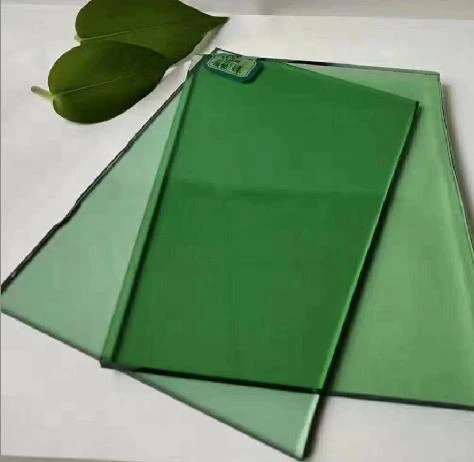Float glass, a staple in modern construction and design, revolutionized the glass production industry with its uniformity and quality. Unlike traditional glassmaking techniques that often resulted in imperfection-laden surfaces, float glass emerged as a remarkable innovation, ensuring consistently flat and clear glass sheets. This method, pioneered in the mid-20th century, involves pouring molten glass onto a bed of molten tin. The glass naturally spreads out to form a perfectly flat surface due to its high temperature and gravity’s equalizing influence. This breakthrough allowed manufacturers to produce glass with an unprecedented level of smoothness and optical clarity, propelling it to primacy in both architectural and decorative applications.

Float glass's significance extends beyond its manufacturing process, impacting structural and aesthetic elements in various industries. In architecture, it offers designers the liberty to create expansive windows and facades, promoting natural light infiltration and energy efficiency within buildings. The uninterrupted surfaces of float glass enhance views and augment the sense of space inside structures. From grand skyscrapers to residential buildings, float glass meets both functional and aesthetic demands, contributing significantly to sustainable building practices.
In interior design,
float glass's adaptability is equally transformative. Designers capitalize on its versatility to create furniture, partitions, and decorative elements that align with modern minimalistic and contemporary styles. The clear and non-distorted quality of float glass is particularly valued in developing mirrors, tabletops, and shelving, ensuring they seamlessly integrate into varied environments while retaining a luxurious feel.

float glass meaning
The technological advances in float glass production further underline its role as a product capable of embracing specialty applications. It sets the foundation for producing laminated and tempered glass variants, enhancing safety and durability—two critical aspects in construction safety standards. When laminated, it withstands impacts without shattering completely, thus preventing injuries and reinforcing its place in automotive windows and skylights. When tempered, it breaks into small, harmless pieces, offering an added layer of protection crucial for shower doors and facades subjected to high wind loads.
Automation and precision in the float glass manufacturing process also underscore the industry's commitment to efficiency and ecological responsibility. Modern facilities implement cutting-edge technologies such as computer-controlled processes to ensure minimal waste and energy consumption, aligning with global trends toward greener industrial practices. These advances not only uphold the environmental sustainability of float glass production but also reflect the industry's adaptability to emerging environmental standards and consumer expectations.
For industry professionals and consumers alike, understanding float glass's inherent qualities and potential applications fosters informed decision-making when selecting materials for construction or design purposes. Its unmatched flatness, clarity, and subsequent adaptability position float glass as a leading choice in various scenarios. By continually evolving and meeting the challenges of modern construction and environmental disciplines, float glass remains a testament to natural resource utilization and innovative thought in design and functionality.
 Afrikaans
Afrikaans  Albanian
Albanian  Amharic
Amharic  Arabic
Arabic  Armenian
Armenian  Azerbaijani
Azerbaijani  Basque
Basque  Belarusian
Belarusian  Bengali
Bengali  Bosnian
Bosnian  Bulgarian
Bulgarian  Catalan
Catalan  Cebuano
Cebuano  Corsican
Corsican  Croatian
Croatian  Czech
Czech  Danish
Danish  Dutch
Dutch  English
English  Esperanto
Esperanto  Estonian
Estonian  Finnish
Finnish  French
French  Frisian
Frisian  Galician
Galician  Georgian
Georgian  German
German  Greek
Greek  Gujarati
Gujarati  Haitian Creole
Haitian Creole  hausa
hausa  hawaiian
hawaiian  Hebrew
Hebrew  Hindi
Hindi  Miao
Miao  Hungarian
Hungarian  Icelandic
Icelandic  igbo
igbo  Indonesian
Indonesian  irish
irish  Italian
Italian  Japanese
Japanese  Javanese
Javanese  Kannada
Kannada  kazakh
kazakh  Khmer
Khmer  Rwandese
Rwandese  Korean
Korean  Kurdish
Kurdish  Kyrgyz
Kyrgyz  Lao
Lao  Latin
Latin  Latvian
Latvian  Lithuanian
Lithuanian  Luxembourgish
Luxembourgish  Macedonian
Macedonian  Malgashi
Malgashi  Malay
Malay  Malayalam
Malayalam  Maltese
Maltese  Maori
Maori  Marathi
Marathi  Mongolian
Mongolian  Myanmar
Myanmar  Nepali
Nepali  Norwegian
Norwegian  Norwegian
Norwegian  Occitan
Occitan  Pashto
Pashto  Persian
Persian  Polish
Polish  Portuguese
Portuguese  Punjabi
Punjabi  Romanian
Romanian  Russian
Russian  Samoan
Samoan  Scottish Gaelic
Scottish Gaelic  Serbian
Serbian  Sesotho
Sesotho  Shona
Shona  Sindhi
Sindhi  Sinhala
Sinhala  Slovak
Slovak  Slovenian
Slovenian  Somali
Somali  Spanish
Spanish  Sundanese
Sundanese  Swahili
Swahili  Swedish
Swedish  Tagalog
Tagalog  Tajik
Tajik  Tamil
Tamil  Tatar
Tatar  Telugu
Telugu  Thai
Thai  Turkish
Turkish  Turkmen
Turkmen  Ukrainian
Ukrainian  Urdu
Urdu  Uighur
Uighur  Uzbek
Uzbek  Vietnamese
Vietnamese  Welsh
Welsh  Bantu
Bantu  Yiddish
Yiddish  Yoruba
Yoruba  Zulu
Zulu 


